Order these records by:
Browse Collection › LC Subject Heading › 15 records found where LC Subject Heading is Carr, Julian Shakespeare, 1845-1924 | ||
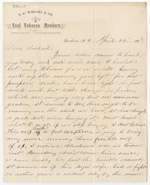 | Letter from Thomas D. Wright to Richard Harvey Wright, April 26, 1886 Thomas D. Wright describes an altercation and "fight" between two women and the public's response to Mr. Blackwell's sudden departure to Raleigh. | |
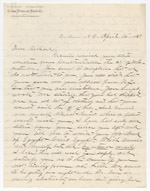 | Letter from Thomas D. Wright to Richard Harvey Wright, April 16, 1889 Thomas Wright reports on the fiscal situation of the Durham Bobbin & Shuttle Mills Co.:" Expenses up to this time are greatly in excess of out put [sic] of work." He also notes that Dr. Carr is treating Richard's daughter Little May with electricity. | |
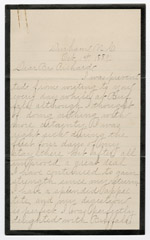 | Letter from Annie E. Snow to Richard Harvey Wright, October 01, 1889 Annie E. Snow shares family news with her brother-in-law Richard H. Wright. She also describes her meeting with the Methodist preacher Sam Jones, William T. Blackwell's bankruptcy and Julian S. Carr's travels. | |
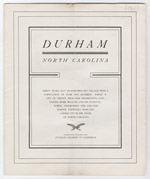 | Durham, North Carolina : thirty years ago an insignificant village with a population of some five hundred A Durham Chamber of Commerce booklet, published in 1906, which presents a short history of Durham as well as numerous photographic illustrations of educational institutions, churches, manufacturing establishments and street scenes. The pamphlet also includes statistical information about Durham County and its schools. | |
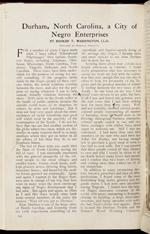 | Durham, North Carolina, a city of Negro enterprises Booker T. Washington, principal of Tuskegee Institute, penned this essay in 1911 for the illustrated magazine, Independent. Washington, recounts his travels to Durham and gives his observations about race relations in Durham. Washington discusses the economic and cultural contributions of many prominent members of the African American community including: Richard B. Fitzgerald, Aaron M. Moore, Richard E. Clegg, John Merrick, and Charles Clinton Spaulding. He devotes much of his analysis to the economic development of the black community in a place that he dubbed, “City of Negro Enterprises.” | |
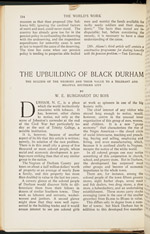 | Upbuilding of black Durham: the success of the Negroes and their value to a tolerant and helpful southern city Essay by W. E. B. DuBois in the World's Work reporting on his visit to Durham, North Carolina in 1912. DuBois analyzes the economic culture and explores the history of race relations in this southern city. DuBois provides a history of black enterprises and educational institutions that served the black community in Durham. The article features photographs of R.B. Fitzgerald, C.C. Spaulding, White Rock Baptist Church, North Carolina Mutual Insurance Company and a view of workers in a black-owned hosiery manufacturing company. | |
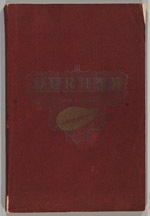 | Hand-book of Durham, North Carolina : a brief and accurate description of a prosperous and growing southern manufacturing town This pocket-sized handbook documents the people, businesses, social conditions, and government of Durham, North Carolina, and compares Durham's industrial and social advantages to other cities of the same size. It includes statistical records and information about Durham's government, health, real estate, taxes, buildings, streets, waterworks, fire departments, electric lights and gas, telephones, hotels, hospitals, markets, schools and colleges, churches, lodges, and social clubs. Included are lithographs of Mangum Street and Main Street and depictions of prominent buildings, such as: Bennett Place; Durham County Court House; the Fire House; Hotel Carolina; City Hospital; Durham Graded School; Trinity College's Main Building; Trinity Methodist Church; Main Street Methodist Church; the Presbyterian Church; the First and Second Baptist Church; bank buildings; the factory of the Blackwell Durham Tobacco Co.; Duke Tobacco Factory; and textile factories. Portraits include Isaac N. Link, ma... | |
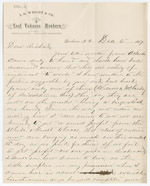 | Letter from Thomas D. Wright to Richard Harvey Wright, December 6, 1887 In this letter to his brother Richard, Thomas Wright, proprietor of the tobacco brokerage T. D. Wright and Company, shares the challenges which he faces in the tobacco market. He also notes that Mrs. Stokes lost both of her conjoined twins after their birth. | |
 | Ordinances and resolutions for the government of the town of Durham, 1873 This 1873 pamphlet records laws for Durham's citizens and visitors. Includes prohibitions on cockfighting, littering, indecent exposure, and firing guns within town limits. Julian S. Carr held the post of mayor of Durham. Edward James Parrish, J. E. Lyon, J. F. Freeland, W. Mangum and James S. Lockhart served on the Durham Board of Commissioners. | |
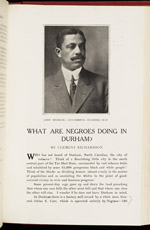 | What are Negroes doing in Durham? Essay by Clement Richardson in the Southern Workman highlighting the achievements of the African American community in Durham in the early 1910s. Richardson focuses on the contributions of black entrepreneurs and professionals including E. R. Merrick, Robert Fitzgerald, Stuart Lynn Warren, John Merrick, Dr. A. M. (Aaron McDuffie), R. H. Clegg, W. G. Pearson, J. S. Scarborough, E. W. Cannady, Dr. F. D. Page, Peyton H. Smith, P. W. Dawkins, Jr. and others. | |
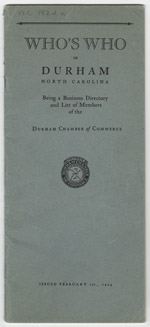 | Who's who in Durham, North Carolina ,being a business directory and list of members of the Durham Chamber of Commerce This 1924 Durham Chamber of Commerce publication contains information about the Chamber and its membership. The pamphlet provides an alphabetical listing of individual members, a classified business directory, and a section of “facts about Durham.” | |
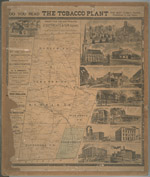 | Map of Durham County, N.C. This 1887 map indicates the location of landowners, churches, quarries, saw mills, creeks, railroads and a coal mine. Includes advertisements for local businesses including the newspaper Tobacco Plant, Seeman Printery, Vaughn & Tenny, druggists and fourteen illustrations of: Morris & Son factory, J.S. Carr’s residence, E.J. Parrish’s residence, Trinity Church, Banner Ware-house, View of Main Street, View of Mangum Street, Durham Hotel (Claiborn), E. Morehead & Co. bankers, Globe warehouse, Durham Cotton mills, Z.I. Lyon & Co.’s tobacco factory, Blackwell’s Co-operative tobacco factory, and W. Duke Sons & Co.’s factory. The map provides the names and boundaries of six Durham County townships including Mangum, Lebanon, Durham, Patterson, Oak Grove, and Cedar Fork. Scale [ca. 1:63,360]. | |
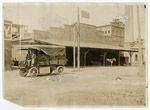 | Photograph of Electric, Ice Plant, Durham Traction Company A 1914 photograph of the Durham Traction Company Light and Power building, in front of which sits a motorized "Electric Truck No. 1," as well as horse-drawn wagons. Richard Harvey Wright was the first president of the company; Julian Shakespeare Carr served as Vice President. | |
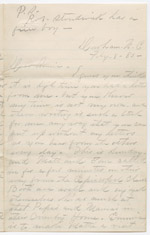 | Letter from Celestia Muse Southgate to Annie Moore Southgate, February 08, 1885 In this letter, from Lessie Southgate to, her sister, Annie Moore Southgate, Lessie (Celestia Muse) Southgate describes events occurring in Durham: a sermon, "musicale," and an upcoming Valentine's Day party. Lessie shares news about the Duke family, Lipscomb family, Blackwell family, Carr family, and Lockhart family. Lessie depicts a horseback outing with Emma Lockhart, Julian S. Carr, and others. While riding through Hayti, she stopped to to see Adaline, one of the family's domestic servants, who is ill. Lessie mentions the arrival of the "Wizzard Oil Band of Singers," a group that performs open air concerts. She concludes her note with humorous news of Annie's dog, Zoe. | |
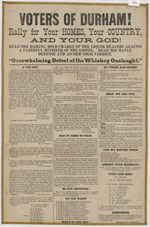 | Voters of Durham! rally for your homes, your country, and your God! The Prohibition Committee of Durham, North Carolina, created this broadside in 1886, to support a slate of candidates who vowed to abolish the sale of liquor. J.F. Freeland ran for mayor while Edward J. Parrish, G. W. Watts, C. C. Taylor, W. J. Wyatt, J. S. Carr, T. M. Stephens and J. S. Durham sought positions as town commissioners. The broadside reproduces an exchange in the Durham Recorder, between liquor dealers and church officials over whether a father sold his children's clothing to purchase alcohol. | |
digitaldurham@duke.edu · About this site · Copyright © 2001 - 2006. Trudi J. Abel. All Rights Reserved.
The copyright interest in the material in this digital collection has not been transferred to the Digital Durham project. These text and images may not be used for any commercial purpose without the permission of the David M. Rubenstein Rare Book & Manuscript Library and the Digital Durham Project. Copyright permission for subsequent uses is the responsibility of the user.
